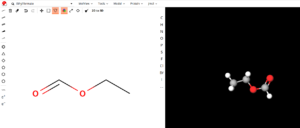A Very Berry Universe
Feature photo: Wild strawberries along the Turquoise Trail in Reston, Virginia. Methyl and ethyl butanoate and methyl and ethyl hexanoate make up the bulk of the esters produced by fresh strawberries. In addition to these esters, other volatile compounds are present in specific cultivars that gave them characteristic flavors.
Article and photos by FMN Stephen Tzikas
The next time you consume some blueberries, blackberries, strawberries, or raspberries and think that their delicious taste is just “out of this world” you may be right.
There is one item in nature that I think future master naturalists, perhaps a few hundred years from now, will recognize anywhere in the universe if they could travel to habitable worlds other than Earth. That item is fruit. While there may be countless numbers of chemical compounds, there is a much more finite number of functional groups. Nature is primarily organic chemistry, though that is not to say inorganic and mineral chemistry are not important, though their classifications are different. Organic functional groups are specific groupings of atoms within molecules that have their own characteristic properties, regardless of the other atoms present in a molecule. Common examples are alcohols, amines, carboxylic acids, ketones, and ethers. In a typical organic chemistry course, there’s about a dozen or two functional groups that are important.
Esters are one of these groups and they are ubiquitous. Esters are derived from carboxylic acids. A carboxylic

MolView’s display of Ethyl Formate, a.k.a. raspberry
acid contains the -COOH group, and in an ester the hydrogen in this group is replaced by a hydrocarbon group of some kind. Esters with low molecular weight are commonly used as fragrances and are found in essential oils. Esters are one of the more useful functional groups, in part because of their low reactivity. In nature, esters are responsible for the aroma of many flowers and fruits.
Some common esters that are present in various fruits include:
- Raspberry: isobutyl formate & ethyl formate
- Pear: isobutyl acetate, propyl ethanoate & propyl acetate
- Apple: pentyl acetate & ethyl pentanoate
- Apricot: ethyl heptanoate
- Pineapple: ethyl hexanoate & allyl hexanoate
- Banana: ethyl butanoate
- Peach: benzyl acetate
“Water, water everywhere, nor any drop to drink” was a saying coined by poet Samuel Taylor Coleridge in his famous The Rime of the Ancient Mariner. Similarly, one can substitute “esters” for “water” in the famous phrase and one might now be speaking of the Universe. Because life in the universe is very likely to be organic based, it would not be surprising to find fruits on another world with the tastes and smells of Earth fruits, even though they may have a different appearance. Nature loves simplicity, and esters are just that. The simplest ester, methyl formate is relatively abundant in star-forming regions. Ethyl formate has been detected too in space. However, as organic molecules get larger they are more challenging to detect within the interstellar medium. Given that ethyl formate has the taste and smell of raspberries, one might conclude it’s a very berry universe. In fact, when it was first detected in our galaxy, the media posted stories humorously proclaiming the galaxy tastes of raspberries.
There is a lot of chemistry in nature, and many people make a hobby of it. A young child might explore with a chemistry kit, but the creative master naturalist enthusiast could get it involved in the extraction of dyes, oils, and fragrances found from plants in nature, to include the extraction of esters. Those who do this, extract wealth first-hand. I have heard it said in the chemical engineering industry that all wealth is either mined or grown, and everything else is an industry derived from this. If you enjoy exploring chemistry, many online resources exist as well as physical molecule building kits. MolView is an intuitive, open-source web-application for science and learning that can help you visualize molecules. It can be found here: https://molview.org
Chemistry is called the central science. Next time you are walking through nature, think about all the chemistry that is involved for anything that has a taste, smell, or color.




